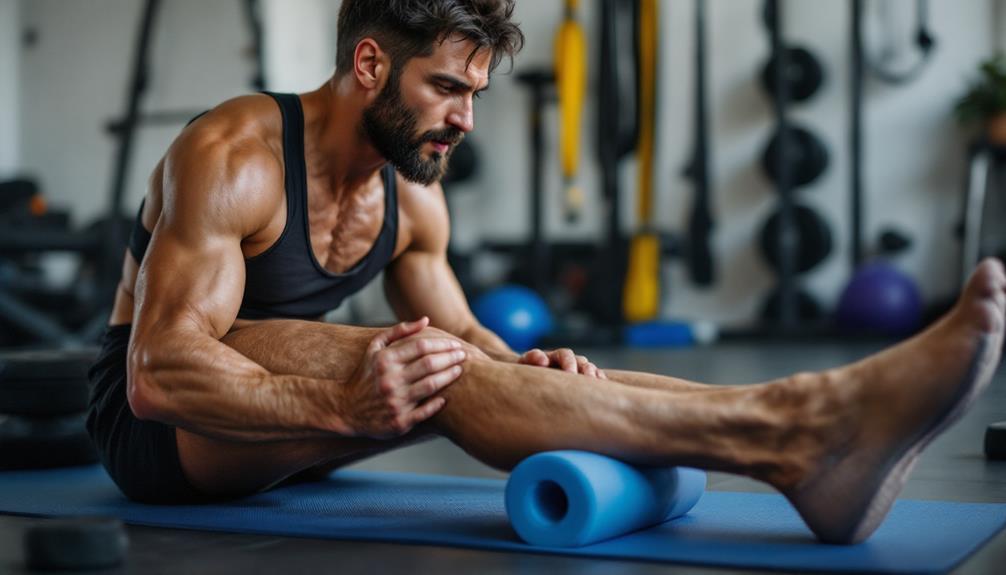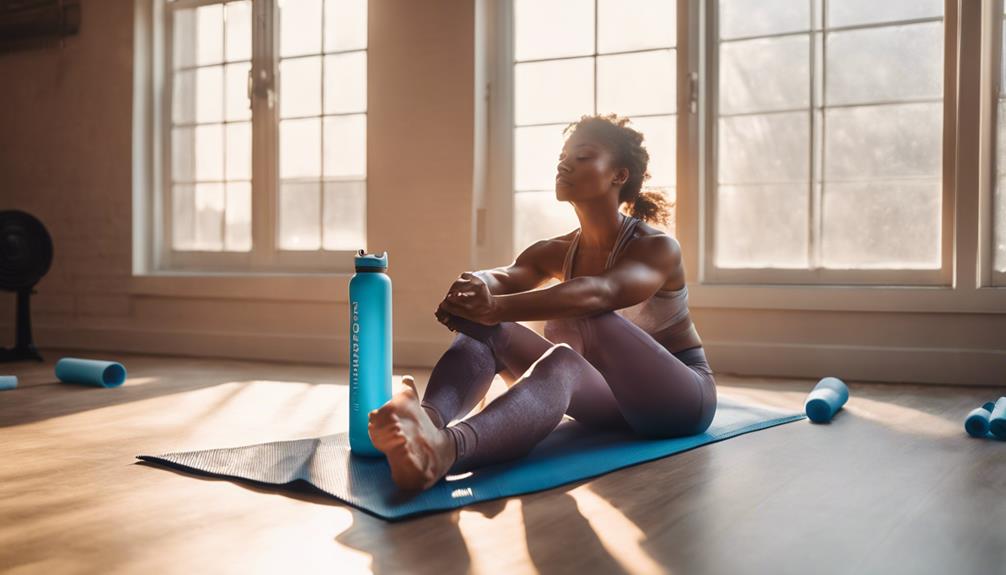To improve your post-workout recovery time, focus on these key strategies: Hydrate before, during, and after exercise, replenishing electrolytes. Consume protein and complex carbs within two hours post-workout. Aim for 7-9 hours of quality sleep nightly. Incorporate proper cool-down and stretching routines. Use foam rolling to target sore muscles. Consider wearing compression gear. Practice active recovery on rest days. Supplement wisely, consulting a professional if needed. Listen to your body's signals, adjusting your routine as necessary. Prioritize proper nutrition, including fruits and vegetables for essential micronutrients. These tips will help you optimize your recovery and boost your fitness gains.
Core Insight
- Stay hydrated before, during, and after your workout to replenish lost fluids and support recovery.
- Consume a balanced meal with protein and carbohydrates within 2 hours post-exercise to aid muscle repair.
- Prioritize 7-9 hours of quality sleep nightly to promote overall recovery and muscle growth.
- Implement a proper cool-down routine with stretching and foam rolling to reduce muscle tension and soreness.
- Listen to your body, adjusting workout intensity and rest periods based on fatigue and soreness levels.
Hydrate Strategically

Hydration is a key part of recovering after a workout. It's important to start drinking water before you exercise and keep hydrating during your workout. When you sweat, you lose fluids, so it's crucial to replace them. After you finish exercising, try to drink water or a sports drink within 30 minutes. This will help restore lost electrolytes and support your recovery. You might want to choose drinks that contain important minerals like sodium, potassium, magnesium, and calcium to help with hydration and muscle function.
Don't just wait until you feel thirsty to drink. By that time, you might already be slightly dehydrated. Instead, check the color of your urine. If it's light yellow, you're doing well. If it's darker, it means you need to drink more. Keep in mind that how much you need to drink can depend on how hard you worked out, how long you exercised, and the weather. Gradually increase your fluid intake and pay attention to how your body feels. Staying properly hydrated can help reduce muscle soreness and speed up your recovery time.
Prioritize Proper Nutrition

Why is nutrition important for recovery after a workout? Your body needs the right nutrients to fix muscle damage, restore energy, and promote overall recovery. Collagen supplements can also help with joint health and muscle recovery after tough workouts. To make the most of your post-workout nutrition, follow these tips:
- Eat protein: Try to get 20-30 grams of protein within 30 minutes after exercising to help repair your muscles.
- Refuel with carbs: Eat complex carbohydrates, like whole grains or sweet potatoes, to replenish your energy stores.
- Add healthy fats: Include foods like avocado or nuts to help reduce inflammation.
- Don't skip micronutrients: A variety of fruits and vegetables supports your immune system and recovery.
- Time your meals: Aim for a balanced meal within 2 hours after your workout.
- Stay consistent: Keep a balanced diet throughout the day to help with ongoing recovery.
Get Adequate Sleep

Sleep is crucial for your body and mind to recover after a tough workout. While you sleep, your body repairs muscles, restores energy, and releases hormones that help with recovery. Aim for 7-9 hours of good sleep each night to get the most out of these benefits. You might also consider melatonin supplements to help improve your sleep quality.
To sleep better, create a bedtime routine. Spend an hour before bed winding down. Dim the lights, stay away from screens, and do relaxing activities. Make your bedroom a comfortable place to sleep by keeping it cool, dark, and quiet. A good mattress and pillows can also help you sleep better.
If you have trouble falling asleep, try deep breathing or meditation. Avoid caffeine and heavy meals close to bedtime. Remember, getting enough sleep is just as important as your workouts for reaching your fitness goals.
Stretch and Cool Down

After a workout, it's important to cool down and stretch. This helps your muscles relax and can prevent soreness later. Start by slowing down for 5-10 minutes to let your heart rate drop. You might also try cold therapy compression wraps to help with recovery and reduce swelling in specific areas. These wraps can soothe your muscles and help control pain.
Once you're cooled down, focus on stretching. Hold each stretch for 15-30 seconds, paying attention to the major muscle groups you used. Avoid bouncing or forcing the stretch; instead, take deep breaths and relax into it. Stretching after exercise can help improve flexibility and lower the chance of injury.
Use Foam Rolling Techniques

How can foam rolling help you recover after a workout? This technique acts like a self-massage, easing muscle tension, improving flexibility, and reducing soreness. By applying pressure to certain points on your body, you boost blood flow and help break up knots in your muscles and tissues.
Using a high-density foam roller gives you firm pressure for a deep massage, which is great for larger muscle groups. Some foam rollers have textured surfaces that provide even better relief.
To make the most of foam rolling, keep these tips in mind:
- Roll slowly over each muscle group for 30-60 seconds.
- Pay attention to areas that feel tight or sore.
- Breathe deeply and try to relax your muscles.
Adding foam rolling to your post-workout routine can help speed up recovery and prevent injuries. Focus on major muscle groups like your quads, hamstrings, calves, and back. Start with light pressure and increase it as you get used to the technique. Remember, being consistent is key for the best results.
Try Contrast Water Therapy

Try Contrast Water Therapy
Foam rolling can help target specific areas, but contrast water therapy takes a more whole-body approach to recovery. This method involves switching between hot and cold water, usually in a shower or bath. Start with warm water for 3-4 minutes, then switch to cold for 1-2 minutes. Repeat this cycle 3-5 times, always finishing with cold water. If you want to focus on certain muscles, you can use textured foam rollers along with contrast water therapy to boost recovery and flexibility.
Contrast water therapy has many benefits. It helps reduce swelling, improves blood flow, and speeds up muscle recovery. The hot and cold temperatures cause your blood vessels to widen and narrow, which helps remove waste from your muscles and brings in fresh, oxygen-rich blood.
You can easily add this method to your post-workout routine. If you don't have a bath, just alternate between hot and cold settings in your shower. Listen to your body and adjust the temperatures to what feels comfortable for you.
Wear Compression Gear

Wearing compression gear can really help with your recovery after workouts. This type of clothing puts gentle pressure on your muscles, which can reduce swelling and inflammation. It helps blood flow, making it easier for your body to get rid of waste and deliver oxygen to your muscles.
Compression levels vary. For light support, look for 15-20 mmHg, while 30-40 mmHg is for medical-grade compression. Higher levels can improve circulation and support. It's a good idea to talk to a healthcare professional to find the right level for you.
Here are some tips for using compression gear effectively:
- Wear it during and after your workout.
- Make sure you choose the right size for the right amount of pressure.
- Focus on areas that need the most support, like your calves or thighs.
Using compression clothing regularly can help reduce muscle soreness and fatigue. It's particularly useful for high-impact activities or endurance sports. While it's not a magic solution, adding compression gear to your recovery routine can really help you recover faster from tough workouts.
Practice Active Recovery

Active recovery is an important part of your post-workout routine. It means doing light exercises that help your muscles recover faster. Instead of resting completely, you will keep your body moving with gentle activities that don't push you too hard.
Here's a simple guide to active recovery:
| Activity | Duration | Benefits |
|---|---|---|
| Light jogging | 10-15 mins | Improves blood flow |
| Swimming | 20-30 mins | Low-impact, works the whole body |
| Yoga | 15-20 mins | Increases flexibility |
| Cycling | 15-20 mins | Builds endurance |
Incorporating these activities into your routine can help you feel better and recover more effectively after your workouts.
Consider Supplements Wisely

Supplements can help with recovery after workouts, but it's important to choose them carefully. Talk to a healthcare professional or nutritionist before adding any supplements to your routine to make sure they are safe and right for you. When looking for supplements, focus on those that have been shown to aid recovery. For building muscle, lean mass gainers can be useful when paired with good training and nutrition. Look for products that have a good balance of carbs and protein, as well as complete amino acids. Here are some supplements to consider:
- Protein powders to help with muscle repair and growth
- Creatine for better strength and power
- Omega-3 fatty acids to help reduce inflammation
Always prioritize your health and well-being when considering supplements.
Listen to Your Body

Listening to your body is one of the most important parts of recovering after a workout. Notice how you feel during and after exercise. If you feel pain, tiredness, or discomfort that seems unusual, it's crucial to take action quickly. Your body gives you signals that can help you avoid injuries and recover better.
| Signal | Meaning | Action |
|---|---|---|
| Sharp pain | Possible injury | Stop and check |
| Lingering soreness | Not fully recovered | Take an extra rest day |
| Excessive fatigue | Overtraining | Lower the intensity |
| Reduced performance | Not enough recovery | Change your routine |
| Improved energy | Good recovery | Keep up your routine |
Frequently Asked Questions
How Long Should I Wait Before Working Out the Same Muscle Group Again?
You should typically wait 48-72 hours before working out the same muscle group again. This allows for proper recovery and muscle growth. However, your specific recovery time may vary based on your fitness level and workout intensity.
Can Massage Therapy Help With Post-Workout Recovery?
You're barking up the right tree! Massage therapy can indeed help with post-workout recovery. It'll increase blood flow, reduce muscle soreness, and improve flexibility. You'll feel rejuvenated and ready to tackle your next workout sooner.
Are Cold Showers Beneficial for Muscle Recovery After Exercise?
Yes, cold showers can benefit your muscle recovery after exercise. They'll reduce inflammation, ease muscle soreness, and improve circulation. You'll feel refreshed and may recover faster. However, don't overdo it; short sessions are best for maximum benefits.
What's the Ideal Protein-To-Carbohydrate Ratio for Post-Workout Recovery Meals?
You'll want to aim for a 1:3 or 1:4 protein-to-carb ratio after your workout. This means for every gram of protein, you should consume 3-4 grams of carbs to replenish energy and support muscle recovery.
How Does Age Affect Recovery Time, and Should Older Athletes Adjust Their Routines?
As you age, your recovery time typically increases. You'll need to adjust your routine by incorporating more rest days, focusing on proper nutrition, and potentially reducing workout intensity. Don't forget to listen to your body's signals.

